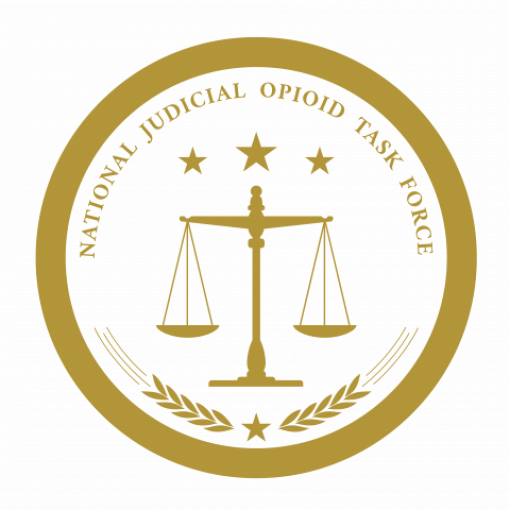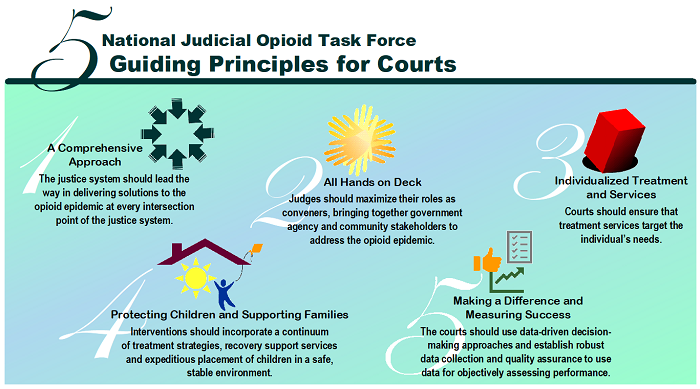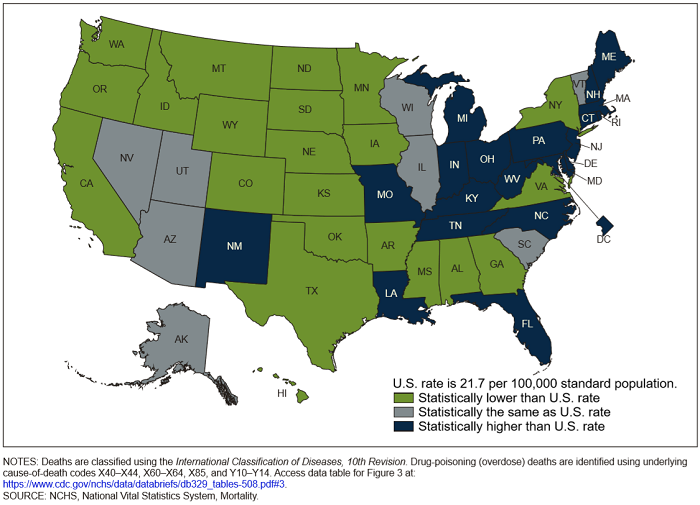National Judicial Opioid Task Force (NJOTF) archive

After a multi-year investigation, the National Judicial Opioid Task Force (NJOTF) on November 20, 2019, released findings, recommendations, and solutions on the role of state courts in addressing the crisis of addiction. The task force was formed in 2017 by the Conference of Chief Justices (CCJ) and Conference of State Court Administrators (COSCA).
 Task Force final report. This report details recommendations, tools, best practices, and examples of successful programs so that state courts can serve as effective partners in the management and eventual end to the addiction crisis.
Task Force final report. This report details recommendations, tools, best practices, and examples of successful programs so that state courts can serve as effective partners in the management and eventual end to the addiction crisis.
Task Force products. This collection of tools was created by the National Judicial Opioid Task Force to assist courts in addressing the opioid crisis.
About the task force
Created in August 2017, the NJOTF's primary focus is to make recommendations to courts at every level to support the judiciary in helping individuals successfully recover from opioid use disorder and lead drug-free lives.
To inform and prioritize the work of the Task Force, the eight-member executive task force committee led by co-chairs Indiana Chief Justice Loretta H. Rush and Tennessee State Court Administrator Deborah Taylor Tate distributed a nationwide survey which revealed six major needs:
- State opioid plans;
- Impact of the epidemic on courts;
- Court interventions for adults, juveniles and families;
- Treatment interventions;
- Specialty court/docket interventions; and
- Funding.
Shortly thereafter, the executive committee developed five principles for state court systems to use as a point of reference in addressing the crisis, and through numerous informational briefs, bench cards, presentations, and videos found in the NJOTF Resource Center for Courts the Task Force has addressed each of the six needs to aid state courts in their battle against opioids.

The Opioid Epidemic 2016-2019
The Court's Role in the Crisis - 2018, Dr. Andrew Kolodny
In 2017, the impact of the opioid epidemic touched every aspect of public safety and the judicial system. In a 2017 survey of chief justices and state court administrators, 55 percent of respondents indicated that the opioid epidemic's impact on the courts in their states was severe. Drug-related arrests involving opioids were skyrocketing. In many communities, court dockets and probation caseloads were filled with individuals with opioid-use disorders.
According to the Centers for Disease Control and Prevention (CDC), an opioid is a natural or synthetic chemical that interacts with opioid receptors on nerve cells in the body and brain and reduces the intensity of pain signals and feelings of pain. This class of drugs includes the illegal drug heroin, synthetic opioids such as fentanyl and pain medications available legally by prescription such as oxycodone, hydrocodone, codeine, morphine and many others.
The CDC reported that between 2016 and 2017, the age-adjusted rate of drug overdose deaths involving synthetic opioids other than methadone (drugs such as fentanyl, fentanyl analogs, and tramadol) increased by 45%, from 6.2 to 9.0 per 100,000; while deaths involving methadone, heroin and natural opioids remained approximately the same.
Number and Age-Adjusted Rates of Drug Overdose Deaths by State, 2017

In addition to the impact of opioid abuse on the criminal courts, the nation’s family courts and child welfare system were deeply affected. A 2018 report by the Administration for Children and Families showed that after years of decline the number of children in foster care was rising. From 2012 to 2016, the percentage of removals nationally due to parental substance abuse increased 13 percent to 32.2 percent.
The Opioid Crisis Explained - 2018, Dr. Andrew Kolodny